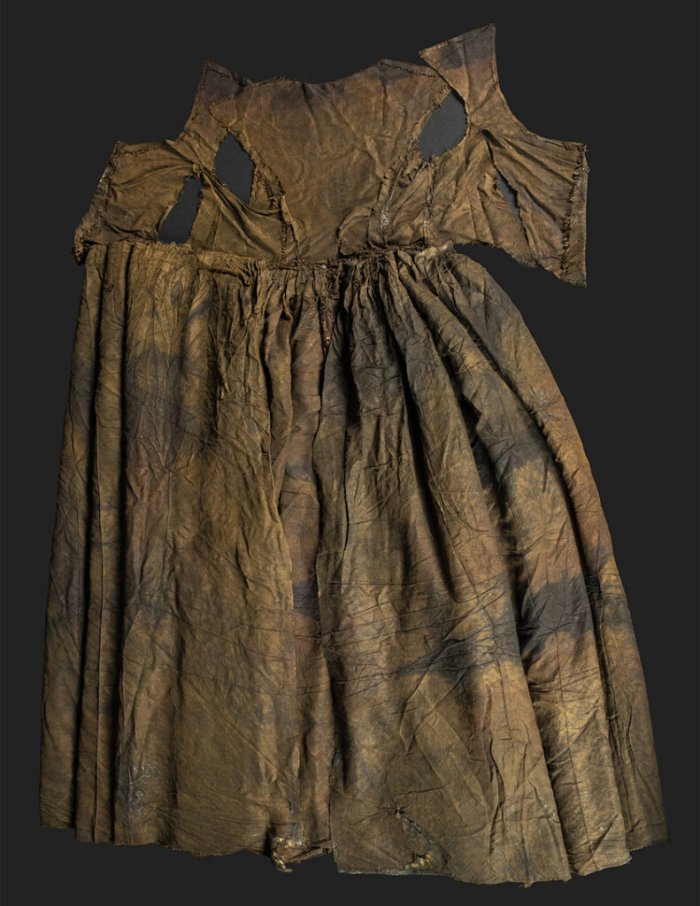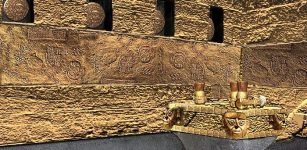Unique 17th Century Silk Dress Found At Bottom Of The Wadden Sea Goes On Display
Jan Bartek - AncientPages.com - The Palmwood shipwreck was discovered off the coast of the Dutch island of Texel in the Wadden Sea.
The ship, whose name is unknown, voyaged in the 17th century, around 1650 or possibly 1660. It sank off the eastern coast of Texel sometime after 1636. Nicknamed Palmwood, the wreck was found in 2009 by Dutch divers, members of a local amateur dive club. In 2014, some artifacts were recovered from the wreck. Among them were two dresses thought to have been made around 1620 and to have been about 30 years old at the time of the shipwreck.
The impressive silk dress was found in a shipwreck that was given the name ‘Palmhout‘ (Palmwood) wreck. The precious garment has remained practically intact despite a stay of almost four centuries on the sea floor. Credit: Museum Kaap Skil - CC BY-SA 4.0
One of the dresses is satin silk damask. The other one is silk interwoven with strands of silver and is believed to be a wedding dress.
The impressive silk dress found in the ‘Palmhoutwrak‘ (Palmwood wreck) is, according to textile restorer Emmy de Groot largely intact and "unique" as a remaining artifact of 17th-century clothing textiles.
Those who want to admire this precious silk dress now have the chance, as it will be exhibited at Museum Kaap Skil.
The Museum Kaap Skil informs, "the precious garment is still in surprisingly good condition despite having lain for almost four centuries on the seabed. It is a unique find worldwide; hardly any clothing from the seventeenth century has been preserved. Scientists expect to need years to answer all the questions that the dress has raised.
The dress is made of silk satin, decorated with a woven floral motif. In the seventeenth century, it would have been referred to as a gown or tabard. Although the dress now has a colorful appearance, including cream, red and brown tints, it is probable that the Dress was originally a single color. It is likely that the initial colorants have perished, whilst stains have occurred from residues of dye from other garments in the same chest.
The dress consists of a bodice with a pleated full skirt which fans open at the front. One or more underskirts would have been worn underneath. The bodice has attached sleeves with loose-fitting ruffles and sleeve caps. Silk tassels would have adorned the sleeves, and they would have been decorated with silver or gilded buttons. All that is still visible on the buttons are the impressions in the fabric. A stand-up collar of linen or lace would have been worn around the neckline, supported by a supportasse or rebato: a metal construction on the shoulders. The garment would have been further decorated with silver and gilded details on the collar, bodice, sleeves, and skirt.
The textile finds which have made the Palmwood Wreck world famous include a second extremely unusual dress. Research has shown that it was probably a wedding dress. With the woven silver discs and embroidered patterns of silver thread it must have been, literally and figuratively, a dazzling dress! Credit: Museum Kaap Skil
The style of the gown is very similar to that of Western European fashion in the early seventeenth century, between about 1620 and 1630. Various comparable garments can be seen in paintings from this time. There appear to be slightly more similarities with English costumes, but the gown would also suit the style of the Dutch Republic or other parts of North-western Europe. It is not inconceivable that the garment had been made in one country and was being transported to another location. After all, the gown was on a journey. For some time, it was thought that the dress once belonged to the Scottish countess Jean Ker. This hypothesis has since been rejected.
The Dress and other unique finds from the Palmwood wreck are on display in a new, spectacular exhibition. A special oxygen-free display cabinet is made for The Dress, which will optimally preserve this showpiece and makes it possible to view it from all angles.
Written by Jan Bartek – AncientPages.com Staff






















